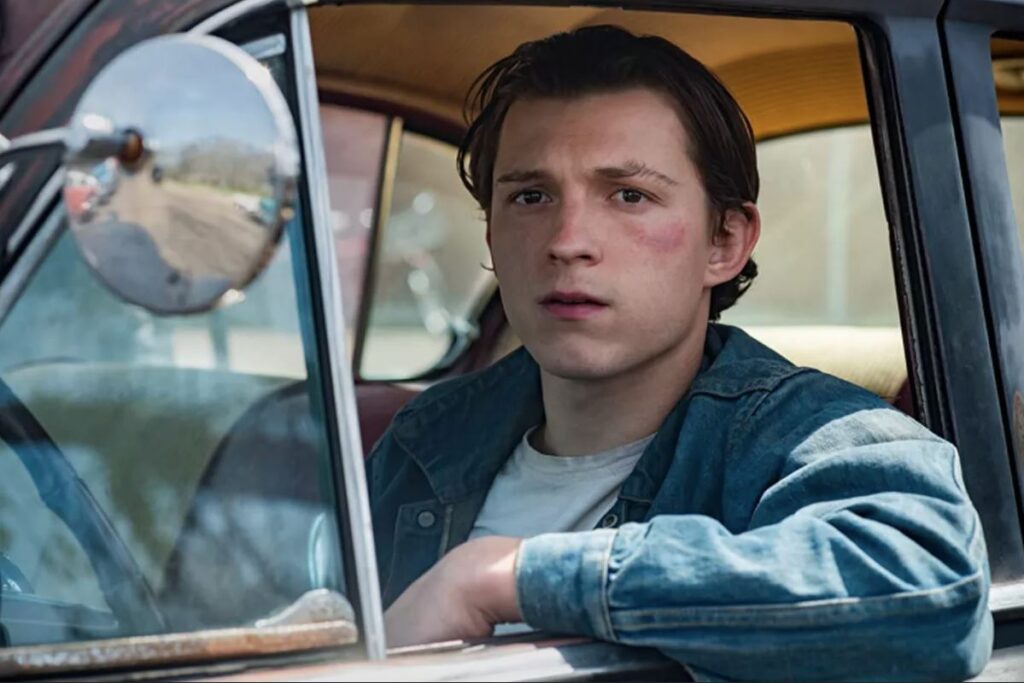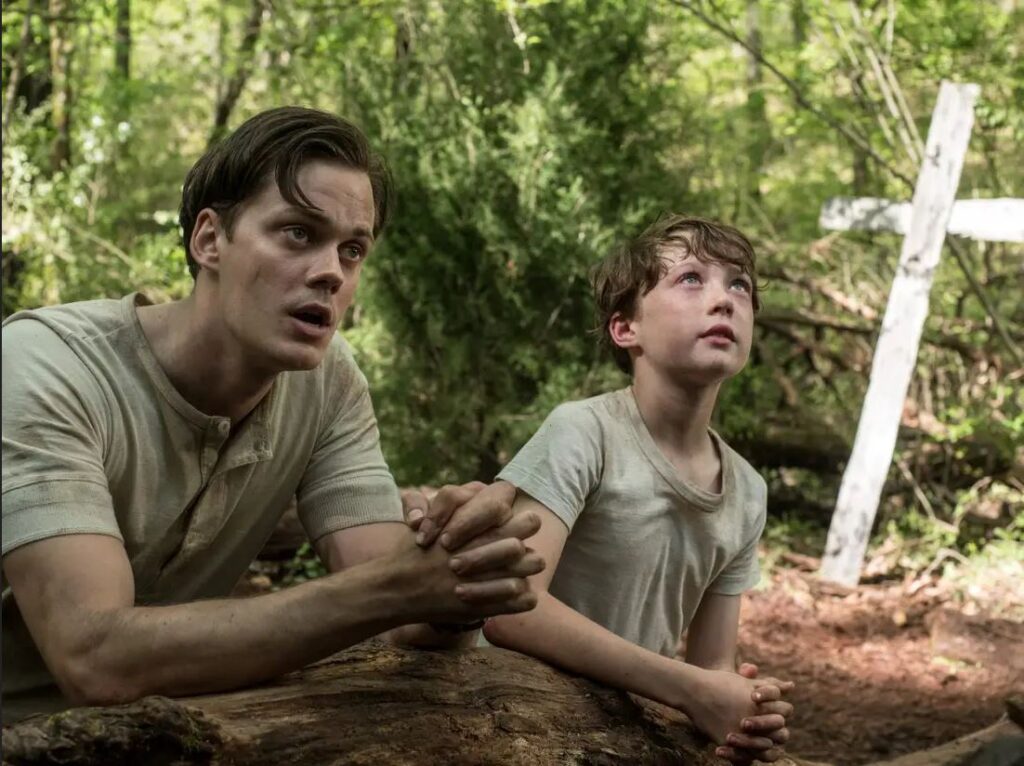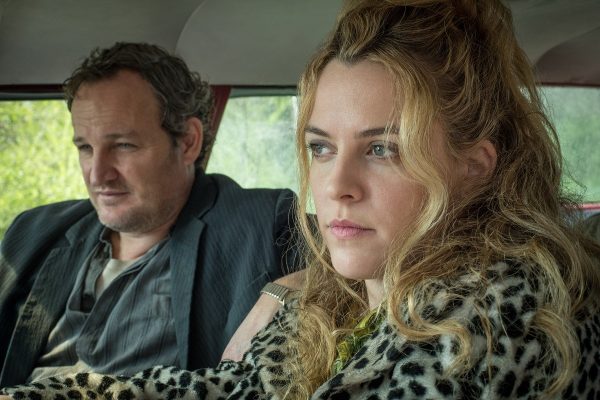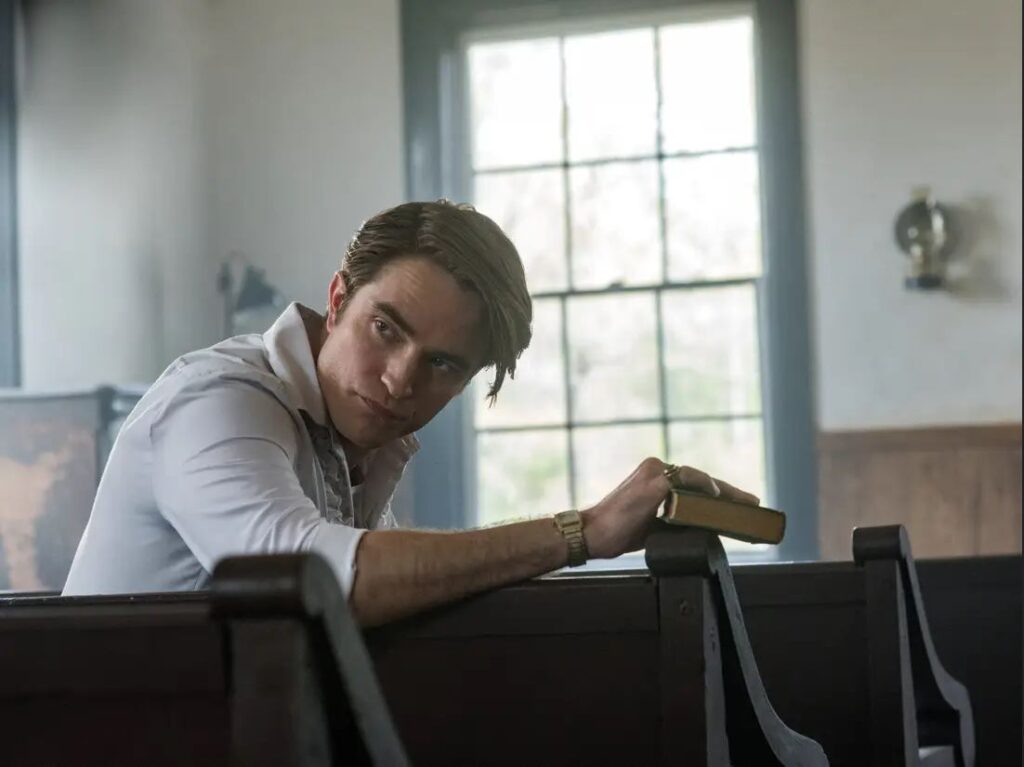
Late in The Devil All the Time, the relentlessly ugly and obdurately watchable new thriller from Antonio Campos, a young man insists that he isn’t a bad person. This may ring false, given that we’ve already seen him kill several people with a pistol and beat up several others with assorted car parts. But wickedness is a spectrum rather than a point, and the competition for the most despicable character in The Devil All the Time—which transpires in various backwaters of West Virginia and Ohio, including an aptly named town called Knockemstiff—is fierce.
There’s the World War II veteran who, in an attempt to convince God to eradicate his wife’s cancer, crucifies his son’s dog. That wasn’t very nice; maybe he’s the film’s biggest baddie. But is he really worse than the charismatic preacher who systematically grooms and rapes teenage girls? What about the other captivating preacher, the one who stabs his wife in the neck in order to hone his gift for resurrection, only to discover that, whoops, death isn’t reversible after all? And let’s not forget the smiling traveler whose hobby is to pick up hitchhikers, photograph them fucking his wife, and then murder them. These guys make David Fincher’s villains look cuddly.
Persistent brutality is one of the themes of The Devil All the Time, which confronts man’s inherent darkness and investigates whether faith—in God, in each other, in ourselves—can somehow redeem us from our instinctual capacity for evil. Or at least, that’s the idea. At once loftily ambitious and unapologetically dirty, the movie plainly aspires to be a resonant adaptation of a Great American Novel: spanning generations, examining interlocking fates, and charting the perpetual war between decency and sin. The screenplay (by Campos and his brother, Paulo) is based on a book by Donald Ray Pollock, who lends his Appalachian drawl as the film’s solemn, insightful, somewhat ponderous narrator.

Pollock’s narration is one of the signifiers of the movie’s grand sweep, as well as one of its many failings. The Devil All the Time initially employs a nonlinear structure before eventually plodding straight ahead, and its early sequences are aggressively haphazard, linked only by Pollock’s somber voiceover. “They found her body out in the woods seven years later,” he intones at one point, as Campos’ camera tracks a cheery woman fatefully climbing into a sedan. That foreknowledge is meant to goose your queasy anticipation, but all it really does is underline the pointlessness of Campos’ discursive approach. Indeed, when he shows you the actual murder a half hour later, the payoff isn’t satisfying so much as compulsory; finally, you can check another victim’s name off of your mental list.
There are quite a few potential casualties to track, and one of the minor pleasures of The Devil All the Time lies in the way Campos hints at mystical connections between its various characters, forcing you to subconsciously unravel the tangled branches of its various family trees. Willard (It’s Bill Skarsgård), traumatized by the horrors of fighting in the Pacific, returns home and marries Charlotte (The Girl on the Train’s Haley Bennett), even though his mother had prayed that he’d wed Helen (Mia Wasikowska, obscenely underserved). She instead ties the knot with Roy (Harry Melling, from the “Meal Ticket” segment of The Ballad of Buster Scruggs), a theatrical clergyman who has an odd relationship with spiders. Their respective unions produce Arvin (Tom Holland) and Lenora (Little Women’s Eliza Scanlen); due to unfortunate events, the two children come of age in the same house. Meanwhile, at the same diner where Willard met Charlotte, her fellow waitress Sandy (Riley Keough, hiding cinema’s most pronounced widow’s peak under a mane of wavy blond hair) encounters Carl (Jason Clarke, because of course he’s in this movie), an agent of chaos with a wide-brimmed hat and narrow blue eyes. Oh, and Sandy’s brother, Lee (the Winter Soldier himself, Sebastian Stan), is a local sheriff, attempting to maintain order in a lawless land.

Got all that? I didn’t even mention the local gangster (Douglas Hodge, always welcome) who taunts Lee in perhaps the film’s most poorly fed subplot. It becomes easier to track everyone with time—as the body count rises, the character count dwindles—but despite flaunting “everything is connected!” pretensions, Campos doesn’t seem especially interested in building out the story as a complex tapestry of interwoven threads. (A late scene where Arvin hitches a ride with Sandy and Carl is presumably intended to serve as a “eureka!” moment of long-awaited catharsis, but it doesn’t carry much oomph.) He’s more invested in exploring the omnipresent specter of religion in his troubled characters’ lives—is belief the road to salvation, or does it lead men astray?—which is why he plainly relishes introducing a new reverend named Teagardin, a happily flamboyant presence played by none other than Robert Pattinson.
Fusing his twitchy body language with a decidedly uncertain accent, Pattinson’s performance is questionable on a technical level. Yet his arrival nevertheless generates some welcome energy, allowing The Devil All the Time to develop a ghoulish momentum that belies its base cruelty. And in general, it’s appealing watching actors of subtlety and grace try to add texture to a work of such blunt-force viciousness. Keough, in yet another role of severe distress (following The Lodge, Hold the Dark, and The House That Jack Built), manages to bring a glimmer of true humanity to Sandy’s predicament, while Holland valiantly resolves Arvin’s inconsistencies, cannily combining tentativeness with internal strength.

Campos, whose last feature was the chilling Christine, is a competent bruiser, and The Devil All the Time’s wanton violence—shootouts, stabbings, suicides—unfolds with stark efficiency and grisly realism. (Guns seem smaller than usual here, as likely to maim as kill.) But there’s no heart beneath the havoc. Any desired commentary about the dangers of religious fundamentalism is too simplistic to be persuasive, and the miasma of suffering is so thick, it prevents us from forming any attachment to the characters.
It’s tempting to declare The Devil All the Time an article of so-called misery porn, but that’s not quite right, because the goal of pornography is to produce pleasure, however dubious or perverse. This movie is too nasty to be enjoyable, nor is it immersive enough to be disturbing. It mistakes pain for power; simply watching people in anguish doesn’t automatically make you feel the weight of their agony. To Campos’ credit, it’s never boring, but in a crude sort of way; you can’t help but wonder what ghastly misfortune will befall its wretched souls next.
Arvin is the film’s nominal hero, making him the logical target for our sympathy. But that’s more by default than anything. Nobody is sympathetic here—just varying degrees of reprehensible. (The men, at least; the women are mostly helpless prey.) Arvin may not be the worst kind of bad person, and The Devil All the Time surely isn’t the worst kind of bad movie. But they’re both destined for Hell all the same.
Grade: C
Jeremy Beck is the editor-in-chief of MovieManifesto. He watches more movies and television than he probably should.
